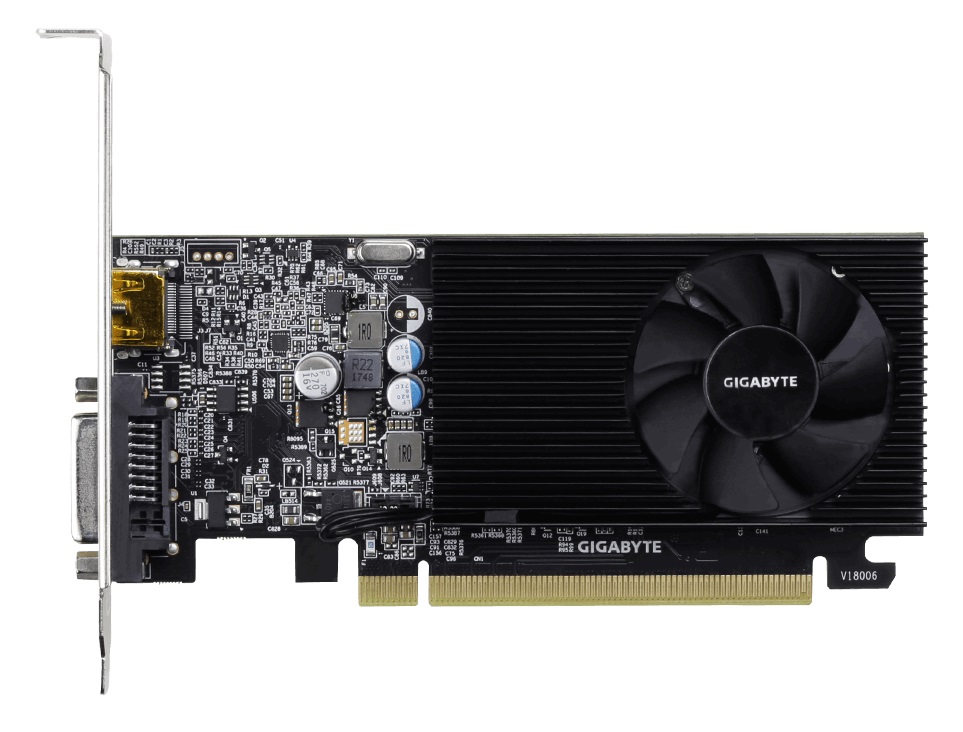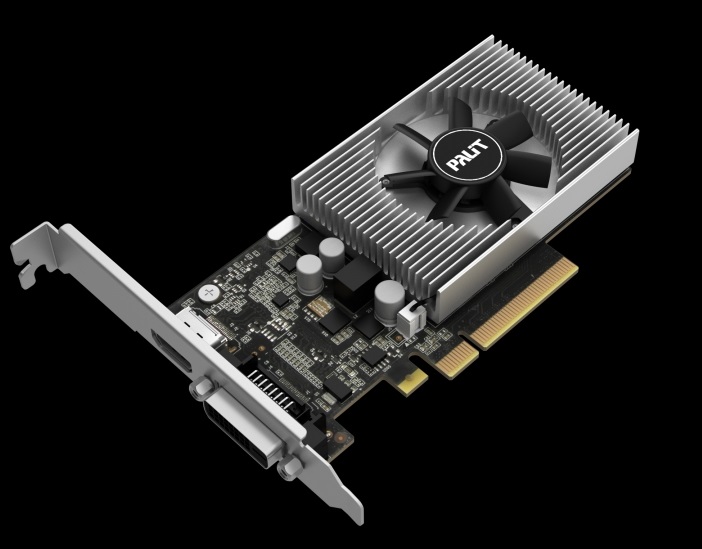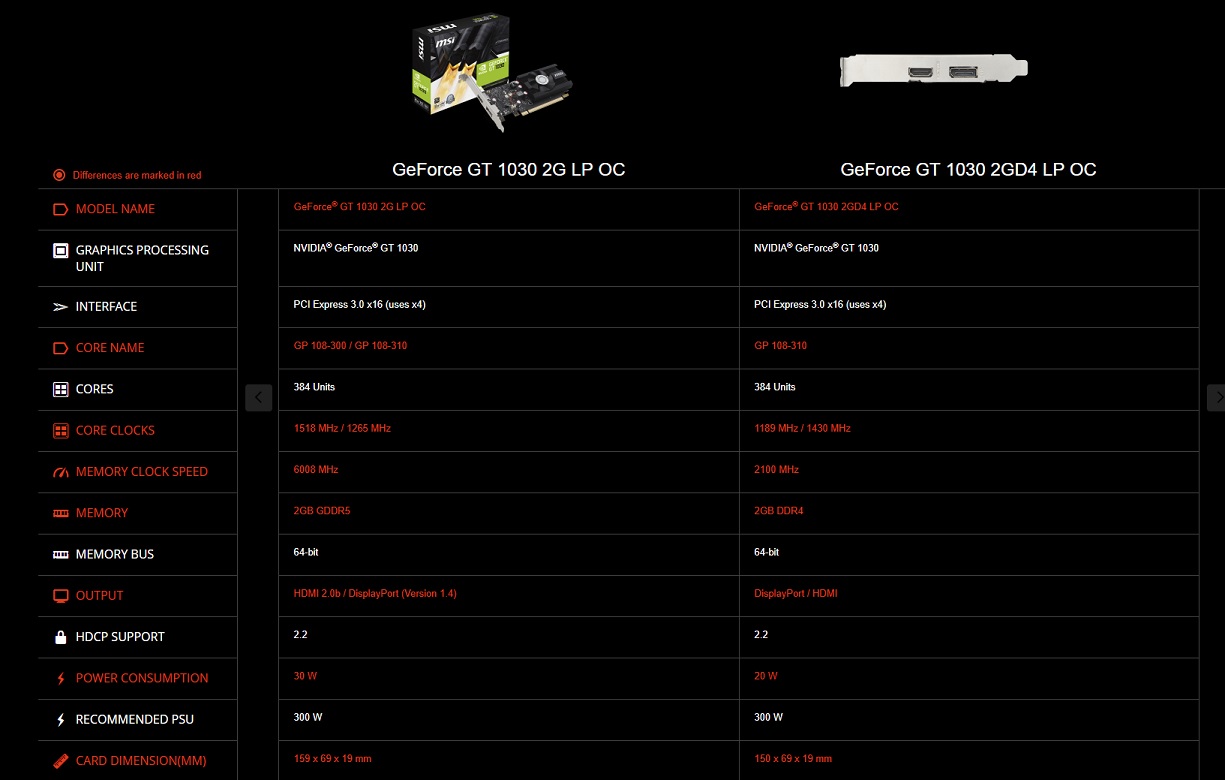Graphics Card Makers Shipping DDR4-Based Nvidia GT 1030 GPUs



Several graphics cards OEMs have released lower-performing versions of the Nvidia GT 1030 that swap the GDDR5 memory of the reference spec for slower DDR4.
Nvidia’s GT 1030 reference spec has a memory bandwidth of 48GB/s. This is calculated from the GDDR5 memory’s 3GHz clock, which is effectively 6GHz due to the nature of double-data-rate RAM, and the 64bit-wide memory bus. Recently, however, lower-spec’d GT 1030 graphics cards have shown up from MSI, Gigabyte, and Palit. Instead of having the standard 3GHz GDDR5 memory, these cards have DDR4 memory that runs at one-third of the reference card’s memory clock.
For example, MSI’s GT 1030 2G LP OC, which is based on Nvidia’s reference spec, is listed with GDDR5 that has an effective memory memory clock of 6008MHz (~3GHz x 2), whereas the GT 1030 2GD4 LP OC is listed with DDR4 memory that has an effective memory clock of 2100MHz. MSI doesn’t explicitly list memory bandwidth as a part of its spec sheets, but a two-thirds drop in effective memory clock implies a two-thirds drop in memory bandwidth. The GT 1030 2GD4 LP OC should have only 16GB/s of memory bandwidth compared to the reference card’s 48GB/s. Both MSI and Gigabyte differentiate their DDR4-based GT 1030 cards by name with a “D4” denotation, whereas Palit does not.
According to MSI’s spec sheets, the DDR4-based GT 1030 cards, at least, have 10W lower power consumption compared to the reference card, which has 30W total power consumption.
This isn’t the first time we’ve seen lower-performing implementations being released in the middle of a GPU’s life cycle. Asrock, which only recently entered the GPU market, also released lower-clocked versions of the AMD RX 560 and RX 550. Although they do not dictate what graphics card OEMs can produce, AMD and Nvidia do rely on reference specs to segment their product stacks. It’s harmful and confusing to consumers when graphics card OEMs, or maybe even the GPU manufacturers themselves, blur their product segmentation after launch with revised products.
Get Tom's Hardware's best news and in-depth reviews, straight to your inbox.
-
King_V The best I can possibly attempt, if I'm being generous, is that these are meant to replace the old DDR3 version of the GT 730 for OEM use (ie: just something to give you the ability to hook up more monitors).Reply
Hopefully it's just that, and that they're WAY cheaper, and NOT that they're trying to slip these by hoping to catch people who don't spot the difference....
-
Giroro I suppose slower memory could make these a lot worse at mining certain currencies.Reply
The question is, how much does it really impact performance of a low-end card like this?
I think a 1030 with slower memory might still be competitive with ryzen 2400G/2200G, as those are also limited to DDR4. If the price is right (meaning below the original $80 1030 MSRP), it could make sense as an upgrade for people with certain intel configurations. But if the price is inflated like current 1030s, forget about it. -
JonDol GPU-Z is showing GDDR5 (Micron) as memory type on my MSI GT 1030. I wonder if it will correctly show DDR4 for those cards...Reply -
King_V Reply20857084 said:I suppose slower memory could make these a lot worse at mining certain currencies.
The question is, how much does it really impact performance of a low-end card like this?
Look at the different positions in the GPU Hierarchy Chart of the GT 730 64-bit GDDR5 versus the GT 730 128-bit DDR3.
It can make a huge difference.
(Ignore the GT 730 128-bit GDDR5 entry - I'm not sure what that is supposed to be, I think that's a spurious entry as I don't believe any such card exists)
-
cryoburner Reply
The problem with such a comparison is that the integrated Vega graphics in those Ryzen processors is already being held back by the slower memory. It's likely that those IGPs would be notably faster if they had access to GDDR5. And as far as new budget builds are concerned, you still need a separate processor to go with a GT 1030, so it's still not exactly all that competitive from a cost perspective, especially with GT 1030s all priced over $100 now. A DDR4 1030 might manage to cost a bit less, but the cards only have 2GB of VRAM, so it's unlikely that cheaper memory will make that much of a price difference.20857084 said:I think a 1030 with slower memory might still be competitive with ryzen 2400G/2200G, as those are also limited to DDR4. -
Nintendork And they should cost $30, no more. Hell, the igpu alone of the 2400G is worth less than that considering you get a nice 4c/8t equal to an i7 7700 for $169 igpu included.Reply
This crappy new 1030's would be way worse than a Ryzen 2200G igpu. -
Nintendork Yeah, make no sense when you can just buy the 2200G with bot cpu and gpu for $99 vs a 1030 that will probably cost $79 being lucky.Reply
Just sell your old system and get new mobo+ram. -
FD2Raptor Reply20857372 said:20857084 said:I suppose slower memory could make these a lot worse at mining certain currencies.
The question is, how much does it really impact performance of a low-end card like this?
Look at the different positions in the GPU Hierarchy Chart of the GT 730 64-bit GDDR5 versus the GT 730 128-bit DDR3.
It can make a huge difference.
(Ignore the GT 730 128-bit GDDR5 entry - I'm not sure what that is supposed to be, I think that's a spurious entry as I don't believe any such card exists)
Uh... no. The 730 GDDR3 is a rebrand of the older gen card, while the GT730 GDDR5 is truly part of the 700 series family. -
BFG-9000 64-bit DDR3 GT730 is Kepler at 902MHzReply
64-bit GDDR5 GT730 is exactly the same but with 2.75x the memory bandwidth
128-bit DDR3 GT730 is the old Fermi chip with only 1/4 as many shaders. To be fair those shaders run 2x as fast as Kepler's so effectively is half as many shaders--if it ran at the same clock. It doesn't as the 40nm Fermi version runs at only 700MHz. Sadly, it also has only half as many ROPs too, so the 2x memory bandwidth vs the 64-bit DDR3 version can in no way make up for the less than halved pixel-pushing power. It's probably worse than the Kepler GT710.There is no 128-bit GDDR5 version of the GT730 listed here.
